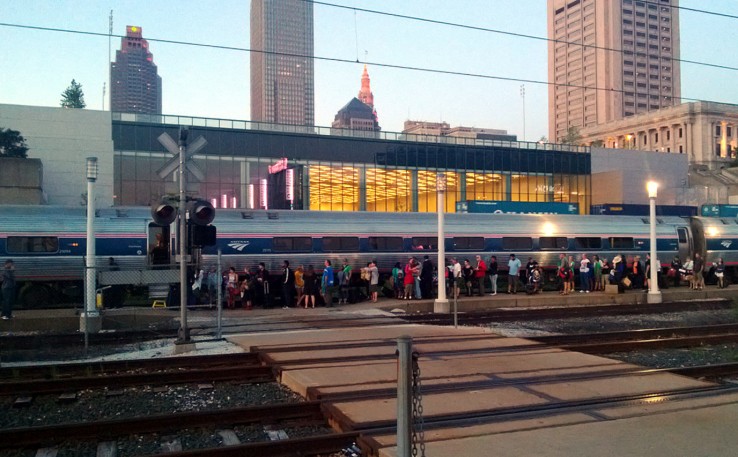On February 25, the NEOSCC Board will be voting on the the Vibrant NEO 2040 Vision, Framework and Action Products. Everyday over the next 5 weeks, we will be sharing an “Initiative A Day” so you can gain a better understanding of the vision and framework! If you would like to read all of the Initiatives, you can download them here: Recommendation and Initiatives.
Show your support for Vibrant NEO 2040 by adding your name to our Champions of Vibrant NEO 2040 list here!
Initiative 5.4: Evaluate the condition of all existing rail trackage and rail crossings to determine what investments would be necessary to bring substandard infrastructure up to standard for freight and passenger service.

WHAT THIS MEANS: Similar to other proposed asset inventory initiatives (3.1, 3.4), a rail network inventory is a necessary first step to considering regional-scale investments in capacity expansion. This initiative would first involve a survey of the current extent of the rail network, including closed and abandoned corridors, using existing geospatial data assets maintained by rail companies, transit operators, port authorities, and MPOs. A field survey should accompany secondary data collection, with particular focus on evaluating the conditions of tracks, bridges, and rail crossings. This process should engage all stakeholders involved in development and maintenance of the rail system, including rail companies, port authorities, transit operators, and MPOs. Once data are collected, stakeholders would evaluate findings and prioritize investment areas based on market demand, safety needs, and prospective future uses.
The evaluation effort should include analysis of the following elements:
- Condition of all rights-of-way including their carrying weights and opportunities for strengthening to increase freight transport demand;
- Opportunities for removal of at-grade crossings; and
- Opportunities for construction of sidetracks to improve operational effectiveness.
WHY THIS IS IMPORTANT: Rail is a vital component of a region’s transportation system. Rail utilization has picked up appreciably in recent years thanks to the price volatility of fuel. This followed years of shrinking in the physical extent of the rail network nationally and regionally, as well as considerable business consolidation in the freight rail industry. An in-depth evaluation of the current state of existing rail assets would help to guide identification and prioritization of strategic opportunities for investment. This could include developing a regional commuter rail network linking various job centers, as suggested in the Vision Map, as well as a larger effort such as developing intercity passenger rail service between Cleveland, Youngstown, and Pittsburgh.
GETTING IT DONE: This initiative should be led by the Ohio Rail Development Commission (ORDC), an entity housed within the Ohio Department of Transportation. ORDC is uniquely positioned to engage rail companies as well as the necessary public sector stakeholders in a way that organizations in Northeast Ohio are not. It also warehouses extensive data resources pertaining to the state’s rail assets.
NEOSCC consortium members, particularly MPOs, should initiate outreach to ORDC highlighting the need for such an inventory and evaluation process. This initiative should, to the greatest extent possible, interface with other initiatives addressing the disposition of vacant land to inform investment priorities in particular kinds of improvements to the rail system. Once under way, a short-term moratorium should be placed on creating new at-grade crossings and converting freight rail rights-of-way to any other use, until the evaluation is complete.
Lead |
Ohio Rail Development Commission; Metropolitan Planning Organizations |
Target Community |
Strategic investment areas, asset risk areas, cost risk areas |
Implementation Complexity |
Moderate |
These recommendations, initiatives, and products, are not one-size-fits all and some aspects of the initiatives won’t be applicable everywhere in the 12-county region. The Vibrant NEO 2040 Vision, Framework and Products are intended inspire and guide decision-making at the Metropolitan Planning Organization (MPO), Council of Government, and local levels to ensure that land use, transportation, and environmental considerations are simultaneously addressed by their processes. Ultimately, the implementation of Vibrant NEO 2040 is up to Northeast Ohio’s communities and residents. But regardless of the applicability of each initiative to any particular part of the region, the goal for each community within the Vision is the same: stability, prosperity, and a high quality of life for all of its residents.
